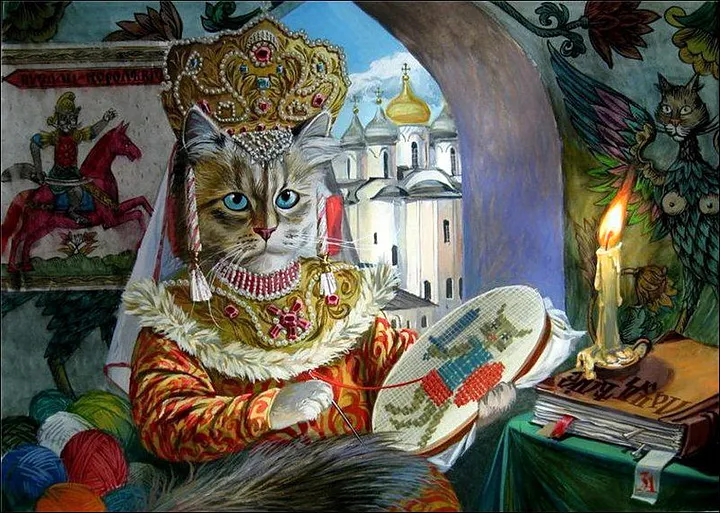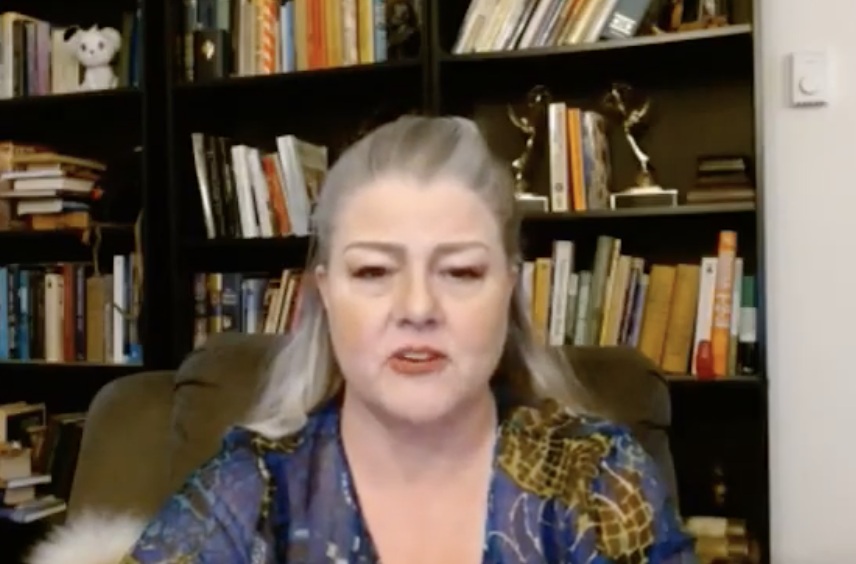“The Keeper of Dreams”

 Deborah L. Armstrong
Deborah L. Armstrong
Alexander Zavaly grew up in the Ukrainian Republic of the Soviet Union, in the town of Alexandria (Ukrainian: Oleksandriia), about an hour’s drive west of the Dnieper River and five hours’ drive southeast of Kiev. He lived there from the age of six, when his family first relocated there, far from the icy mining town of Vorkuta, above the arctic circle, where he had lived since his birth in 1955.
As a child, he was gifted with the ability to draw, but had little opportunity to develop his budding talent. Alexandria was another mining town and his father worked the mines like most of the men in his family, who had no real connection to the world of art.
“So I was a typical self-taught artist, someone who had no initial art literacy,” Zavaly told me in Russian, via instant messaging on VKontakte, the Russian social media platform. Indeed, his life might have taken a very different path had he not met Stepan Nikolenko, a well-known artist in Alexandria who taught at the college there. Zavaly sneaked into Nikolenko’s lectures about art while he was finishing with his own courses at the university. The professor, he says, “infected” him with art and guided him on the path to truth.
Nikolenko counseled young Alexander to pursue his drawing, and after he finished with school in 1978, Zavaly went to the Kuban region of the USSR, in the North Caucasus, where he joined the faculty of art and technical graphics at the university in Krasnodar. From that point on, Zavaly says, “I always worked as an artist, albeit in different genres: as a decorator, interior designer, theater and film artist, as a prop maker and model maker, book illustrator, portrait artist. What was demanded by society at that moment was what attracted me.”
“I have absolutely no breakthrough qualities,” he adds, referring to his ability to market or advertise his work, “and I’ve always naively thought that talent will break through on its own, that’s still the Soviet perception in us. So everything took off on its own, without producers or advertising campaigns. My work has gained some popularity, but I’m not recognized on the streets, I’m not asked for autographs.”
Yet a simple internet search of “Alexander Zavaly” turns up endless examples of his work, and though some of it has been shared with his permission, unfortunately a lot of his art has also been pirated. “I saw an ad on the Internet,” he recalls, “For sale: a copy of Alexander Zavaly’s painting ‘Keeper of Dreams’ — a very bad copy, by the way!”

“Where Are You, My Beautiful Knight?” 30x45cm. 2011. Gouache and watercolor on paper.
And Western sanctions on Russia have made it difficult, if not impossible, for him to sell his work outside of his country. “No one has benefited from the sanctions,” he says, “but they are an inconvenience to everyone. What can I do to help? I can allow connoisseurs of my art to download the paintings themselves, print them out, and use them, but not for commercial purposes.”
I asked him if he has any favorites among his prolific collection. “Paintings are like children,” Zavaly said, “you love them all. Audiences love the ‘Keeper of Dreams’… I like those paintings which are long-nurtured and complicated in the execution, in which warmth and love are invested [such as] ‘The Universe and the Planets.’” He also likes philosophical works such as “The Water has Gone” and “999 Points.” And ironic paintings such as “Conflict of Interest.”
Military themes are common in his work, which often features carefully detailed military uniforms, weapons, and vehicles. Like most young men growing up in the Soviet Union, Alexander served two years in the Soviet Army. Though World War II, known as the Great Patriotic War in Russia, was already over when Zavaly was born, it was still a raw memory, “and all the men in my family fought,” he recalls, including his father and two grandfathers. “One grandfather and an uncle were killed, all fought with the Germans, except my father, he fought with the Japanese, and he went to war — having barely reached the age of conscription in 1943 — as a teenager and came out as a mature, brave sergeant, commander of an anti-aircraft gun, shooting down Japanese ‘Zeroes.’”
“At that time,” Zavaly continues, “everything was saturated with the shock of loss and the euphoria of victory. The country was licking its wounds, the military theme was extremely popular in society.”
In spite of these factors, Zavaly had no plan to join the military and hoped he could avoid it on account of poor health. But in the end, he and his classmates all graduated with college degrees and military certificates. “So I became a commander of a motorized rifle platoon and received the epaulettes of a lieutenant,” he remembers. “But it did not mean that we would automatically go to the army. Most of us did, but I was ‘lucky.’ After some time I received a summons. I put on my uniform and went to command a platoon in the GDR [East Germany].”
“I won’t curve my soul,” he adds — using a Russian idiom which means “I’m not gonna lie”— “and say that I went with desire, but I served 2 years with dignity, got the hang of it, became a good officer and now I think the Army gave me a lot in terms of organizing my ‘inner space,’ finding my center, self-assertion, responsibility. It was like straightening a blade on a stone.”
“Thank God, I did not participate in combat,” Zavaly continues, “but I have encountered NATO soldiers in peaceful situations, literally head-to-head and nose-to-nose. As a rule it happened in Berlin, in Treptow Park, where there is a monument to the Warrior-Liberator in honor of our common victory over Germany, which we — and they — liked to visit.”
The idea of painting cats in military garb was at first just a private way that the artist could combine his love of cats and his fascination with the history of military uniforms. “But at first it was just a funny picture for my own use, ‘for the soul,’ he recalls. “I wasn’t going to put it on public display, as there were doubts about the ethics of such an image. Then I noticed the favorable reaction of my friends and the public. I started to develop the theme, not only military men, but also cosmonauts, fairy-tale characters, poets, and rock musicians appeared. But I think that this ‘cat’ theme, in the end, played a cruel joke on me. On the one hand they brought me fame, but on the other hand they overshadowed my other serious part of creativity, for the sake of which I do art. I hope that this publication will at least partially correct the imbalance…..”
To be fair, Zavaly did paint dogs — Nazi dogs, which were, appropriately, German breeds. But not everyone was pleased. “The ‘dog people’ still resent me for that painting,” he says. “They say that I paint cats as positive characters, while I portrayed dogs as Nazis. But who else could be used in this capacity, if not a German Shepherd and a Doberman, which just ‘asked for’ this role!”
Of course, as you have already seen above, Zavaly paints many different subjects, not all of them military, and not all of them cats. But cats do play a special role in his life. “Cats have always accompanied me,” he says. “They come and go. All my cats are rescued from a difficult, tragic fate, but now they are surrounded by love and care. There are three of them. Belyash, Sonya, and Glasha. Belyash, because he is white [the Russian word for “white” is “beliy”] and Russian-speaking people will smile when they hear this name, because this is the name of a kind of meat pie.”
Throughout his career, which began in 1978, Alexander Zavaly has painted cats, dogs, and just about everything else. “I was a free artist, fed only by my talent. I took on any artistic work: I painted Lenin, political slogans of the Communist Party, painted murals in schools, decorated interiors and painted portraits to order. And I always painted genre paintings for exhibitions. In 1990 I had my personal exhibition in Moscow. The painting ‘Breakthrough of the Noosphere’ was purchased by the Ministry of Culture of the RSFSR (Russia). My paintings are also in art museums of Krasnodar, Kaliningrad, private collections.”
But the most interesting stops along his creative path, Zavaly says, were in the theater and cinema. “‘Torikos’ is a city theater, where I worked as chief artist for 5 years,” he recalls. “This year marks 20 years since my first movie project, ‘Keys to the Abyss,’ where I worked as a set designer. Later there were such famous projects as ‘The Apostle,’ where I designed sets and even played a cameo role. The film about 28 Panfilovs (about the defense of Moscow in 1941), ‘The Last Frontier.’ I am in love with working in the movies to this day.”
Today, Zavaly works in a museum where he puts his unique talent to use every day, creating portraits of historical figures, reconstructing historical events and building complex dioramas and detailed scale models.
“Everyone should do their own thing,” he says, “a teacher should teach, a doctor should heal, an artist should paint, politicians should do politics, the main thing is to be honest so that you are not ashamed of your deeds before your conscience, children and ancestors.”
 Deborah Armstrong currently writes about geopolitics with an emphasis on Russia. She previously worked in local TV news in the United States where she won two regional Emmy Awards. In the early 1990’s, Deborah lived in the Soviet Union during its final days and worked as a television consultant at Leningrad Television. You can support Deborah’s writing at Paypal or Patreon, or donate via Substack.
Deborah Armstrong currently writes about geopolitics with an emphasis on Russia. She previously worked in local TV news in the United States where she won two regional Emmy Awards. In the early 1990’s, Deborah lived in the Soviet Union during its final days and worked as a television consultant at Leningrad Television. You can support Deborah’s writing at Paypal or Patreon, or donate via Substack.Print this article
The views expressed herein are solely those of the author and may or may not reflect those of The Greanville Post. However, we do think they are important enough to be transmitted to a wider audience.

Unfortunately, most people take this site for granted.
DONATIONS HAVE ALMOST DRIED UP…
PLEASE send what you can today!
JUST USE THE BUTTON BELOW
Did you sign up yet for our FREE bulletin? This work is licensed under a Creative Commons Attribution-NonCommercial 4.0 International License ALL CAPTIONS AND PULL QUOTES BY THE EDITORS NOT THE AUTHORS |






















